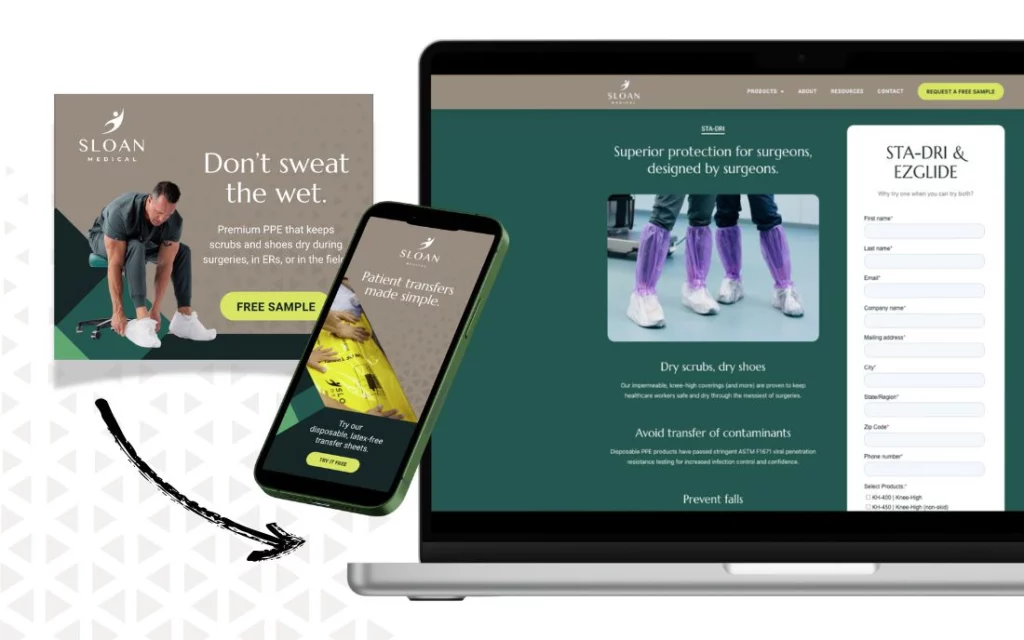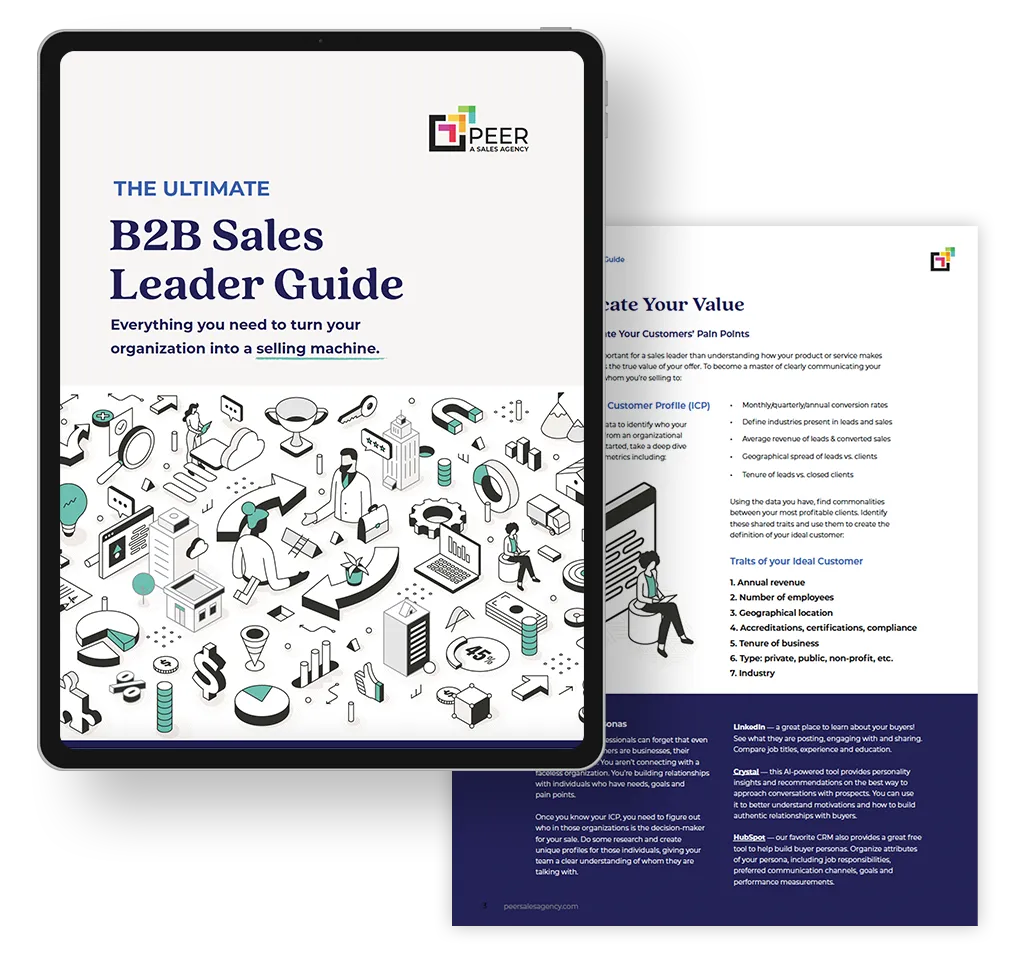Have you ever wondered why some marketing campaigns take off like a jet while others fail to get off the ground? The landscape of B2B marketing is constantly evolving, and what worked yesterday could be ineffective today.
Businesses are inundated with marketing messages from every angle, on every website, almost every waking hour of the day. Standing out from the competition and building brand awareness with your buyers is harder than ever.
Crafting successful B2B marketing campaigns demands a blend of creativity, data-driven strategy, and customer-centricity. If you want to transform your campaigns (and your results) from mediocre to exceptional, let’s explore the five best practices that should build the foundation of every B2B marketing campaign.
What is an Integrated B2B Marketing Campaign?
The best B2B marketing campaigns surround your buyer with a consistent message. This happens over a period of time across a variety of channels they already use and trust. An integrated marketing campaign of this type combines online and offline strategies to reach a target audience with helpful, interesting, or enjoyable marketing messages.
By combining various marketing tactics — from paid ads, content marketing, blog posts, and social media to email and events — you can reach your target audience more effectively. This approach allows for a varied yet unified customer experience, making it easier for potential clients to engage with your brand.
Integrated campaigns also allow for better data collection and analysis, helping you to refine your strategies and increase ROI. Ultimately, a well-executed integrated B2B marketing campaign can strengthen relationships, boost credibility, and drive business growth.
The Difference Between B2B campaigns and B2C campaigns
B2B marketing strategies necessarily differ from B2C strategies. B2B campaigns typically involve longer sales cycles, and the campaign itself will roll out over a longer period of time. Companies and their sales reps develop relationships and earn trust in months and years.
B2B buyers require a lot more from your marketing than a fun and catchy message. You’ll need to be prepared with proof of your claims, content that helps them understand their problem/pain, guides to help them weigh their options, and a fully fleshed-out website that allows them to do their own research.
Because of that, B2B campaigns often use detailed content, like whitepapers and case studies, to prove their worth to buyers. For example, a software company may send a detailed case study to showcase real-world benefits and results to a skeptical prospect.
On the other hand, B2C campaigns tend to be quicker. They aim to attract and engage individual buyers and often use catchy ads and social media posts. A good example is a brand running a fun Instagram contest to encourage purchases of a trending item, like Stanley cups.
Another difference lies in decision-making. B2B decisions usually involve multiple stakeholders – up to 10 different people will weigh in on the decision to purchase a B2B service or product – so your B2B marketing strategy needs to reach all those stakeholders. B2C decisions generally rest on the individual consumer or the consumer and a partner.
According to research, 65% of B2B buyers prefer to conduct most of their research online using product websites, blogs, guides, and webinars. In contrast, B2C buyers often rely on personal recommendations, reviews, and social content.
5 Best Practices for Integrated B2B Marketing Campaigns That Work
With the marketing landscape so cluttered, you’re competing for attention no matter what channels you choose. To compete, you’ll need to do a bit of research, craft a responsive and well-informed strategy, use the right tools to streamline the process, ensure consistency, measure results, and engage your audience.
By following these five best practices, B2B companies can connect better with their target markets and achieve their campaign goals.
Define a Clear Target Audience & Be Specific
Great marketing campaigns start with two questions:
What do we have to say?
Who are we saying it to?
To craft the right message, you’ll actually need to start with the second question and decide who you’re going to be talking to with this campaign. Different types of buyers respond to different messaging styles. For example, a corporate legal office looking for a fractional CMO is likely to respond to a fact-based, data-driven message. On the other hand, a chain of children’s daycare centers looking for a cleaning products vendor is more likely to respond to an emotional message of safety and sanitation paired with proof of success.
To know the difference for your business, you’ll need to define a clear target audience for your B2B marketing campaign and start by creating a persona. A persona is a detailed, semi-fictional representation of your ideal customer. Personas are based on the demographic and psychographic information of your real customers, paired with industry research. For example, if you sell software to schools, your persona might be a technical director at the district.
Next, develop an ideal customer profile (ICP) to help you isolate which accounts or businesses to target with your campaign. This profile lists the key traits your best customers share. For our software example, you might focus on schools with over 1,000 students located in urban areas.
Using both tools helps you understand who to market to. With a persona, you’ll see what motivates your audience. You can identify their challenges, goals, and preferences. Your ICP helps you highlight and narrow the industries, company sizes, and locations to target with your campaign.
Statistics show that companies with clearly defined audiences improve their marketing outcomes. In fact, research shows that targeted campaigns can lead to up to 70% higher engagement rates.
Once you know who you’re talking to, you can use a messaging matrix to clearly communicate your value.
This foundational guide not only serves as a framework for all of your content, but it’s also the key to communicating a clear message that resonates with your customers throughout their buyer journey.
Keep reading: How to Build Your Messaging Matrix
Research Your Market & Document a Strategic Approach
Researching your competition is an important step in planning a successful B2B marketing campaign. Start by identifying your main competitors. You can find them through online searches, industry reports, or social media.
Look at their websites and marketing materials. Notice their messaging and offers. You can use tools like SEMrush or Ahrefs to see what keywords they rank for and even what ads they might be running. This data helps you find gaps in their strategy that you can fill. For example, if your competition is spending $250K a month on search ads, you may not have the budget to compete for the same keywords. So, find gaps in their keyword strategy if you want to include search ads or shift to another strategy entirely, like email marketing.
Once your research is complete, you’ll want to document a campaign plan. Writing things down keeps your ideas organized. It helps you stay focused on your goals. A documented plan gives everyone clear direction. A study showed that companies with documented strategies are 538% more likely to succeed.
To document your campaign plan, use a simple format. Start with your goals. Next, list your target audience. Include your key messages and the channels you’ll use. Create a timeline and budget. Include expectations for performance and benchmarks that you’ll be measuring against. Update the plan as needed to keep it relevant.
Choose the Right Media and Delivery Mix
Now that you know who you’re talking to, what you’re trying to say, and you’ve researched the competition, it’s time to choose the right channels, relevant content, and advertising types for your B2B marketing campaign. You need to meet your audience where they are.
A smart start for your campaign is through email marketing. This channel offers a direct way to connect with potential clients. About 78% of marketers find email effective for engagement, and it’s low-cost enough to run and test multiple messages in the early phases of a campaign.
Next, consider social media content and advertising. Platforms like LinkedIn are great for B2B. They help you reach a professional audience in a business mindset. Around 61% of B2B marketers use LinkedIn to share content, so it’s a place you’ll need to be if you want to compete. Sharing helpful information and recent blogs organically can help you continually nurture your prospects, and LinkedIn ads can serve special offers or CTAs directly to that audience.
Banner or display ads can also be beneficial. They provide brand visibility on relevant websites. A well-placed banner can get your message noticed. These ads are unlikely to convert people directly and serve as part of a greater campaign that surrounds the prospect in your messaging to help your brand stay top-of-mind.
Search advertising is another solid option for your integrated B2B marketing campaign. Using keywords can help you appear when potential clients look for what you’re offering, and it can help them find you online after they’ve seen you in person. You can also leverage search engine optimization to try to capture these keywords organically.
Speaking of seeing you in person, don’t neglect event marketing. Events let you connect face-to-face with potential customers. They help build trust and authority with opportunities to share important information. Event marketing can take a lot of forms, like:
- Conferences
- Trade Shows
- Luncheons
- Webinars
- Field Events
- Seminars & Workshops
- Networking Events
- Launch Parties
From social media posts to hosting events, your campaign can use a mix of these channels to enhance your campaign’s reach. Always analyze your results from each channel to see what works best for your business and buyers.
Bring It Together With the Right Technology
You’re going to need some MarTech (marketing technology) to pull this all off without pulling your hair out.
Many companies use different software or websites to monitor and place content on each channel in the campaign. This makes it hard to stay organized, and it consumes a lot of time and resources. You have to check multiple platforms to get a clear picture of your marketing efforts and assemble manual reporting when stakeholders want to know what’s going on. It’s an inefficient nightmare.
Instead, before you launch an integrated marketing campaign, choose a central marketing platform. With the right tools, you can run all your marketing from one place, integrate all your accounts into this one channel, and run everything from a single command seat. This means you can report on campaign emails, social media, content, and a lot more in one view without manual data gathering.
Studies show that businesses using integrated technology see a 30% increase in marketing efficiency.
Our marketing technology suite of choice is HubSpot Marketing Hub. Easy to learn and easy to scale, HubSpot Marketing Hub gives marketers “octopus arms” and helps integrate disparate channels into one place for efficient management, optimization, and reporting.
Review, Optimize, and Report
You have to prioritize regular review and reporting of the performance of each campaign asset or ad in order to make data-driven decisions. For instance, if an ad gets many clicks but few conversions on the landing page, there might be an issue with the consistency of the landing page messaging or offer compared to the ad.
Optimizing each campaign asset based on this performance data is essential. Suppose an ad shows low engagement on social media. You can change the image or adjust the text to make it more attractive. For example, if a funny video ad performs better, consider using humor in future ads.
Reporting on your campaign using this type of data and analytics helps you understand its overall success and prove important points like ROI and ROAS. Track key metrics like conversion rates, click-through rates, new contacts created, or new deals opened. Use this data to make informed decisions moving forward.
Regularly reviewing, optimizing, and reporting on your campaign assets will lead to better results.
Successful B2B Marketing Campaign Examples
A successful campaign can help a company grow and reach new customers. These campaigns used smart strategies and strong connections to make an impact.
Large Business Example: HubSpot’s “Smooth CRM for Rough Seas” Campaign
HubSpot launched the “Smooth CRM for Rough Seas” marketing campaign to showcase its customer relationship management (CRM) software. The aim was to position HubSpot as a solution for businesses facing tough challenges. The campaign focused on how their CRM helps organizations stay organized and grow, even in difficult times.
This campaign brought real benefits to HubSpot. They saw an increase in user engagement and a noticeable rise in software sign-ups with a 25% increase in conversions during the campaign period.
The “Smooth CRM for Rough Seas” campaign was a clever marketing move that aligned well with the pains and communication style of their buyer persona. It highlighted the benefits of HubSpot’s software in helping these people solve specific problems. Check out one of the video assets from the campaign here.
Mid-market Business: Sloan Medical’s “Try It to Believe It” Campaign

Sloan Medical had spent three decades designing and manufacturing some of the best medical personal protection equipment (PPE) on the market. The only problem? Very few people knew who they were.
Sloan Medical wanted to boost its online presence and attract more leads through an integrated marketing campaign.
This campaign combined different marketing strategies. First, they revamped the website. They made it user-friendly and engaging. Next, they used social media to reach more people. They designed eye-catching posts that drew attention and encouraged shares. Email marketing was also part of the plan. They sent targeted emails and ad campaign content to potential buyers, promoting their superior products and highlighting success stories.
Sloan Medical saw a 500% increase in website engagement, and leads surged by 280%. See the whole story behind Sloan’s success here.
Small Business: Ty’s Outdoor Power “Why Work for Ty” Campaign
Ty’s Outdoor Power needed help to find new employees in a challenging labor market. It’s hard to grow your business without enough employees to keep up with demand!
While this campaign wasn’t targeting other businesses, it was competing with them for quality talent available in the region. This recruitment campaign showed potential employees what makes Ty’s Outdoor Power a great place to work and highlighted the easy-going, supportive nature of the business and its founder, Ty Lisiecki. Ty’s Outdoor Power used video to highlight benefits like a fun work culture and potential for career growth. The campaign included eye-catching video ads, engaging social media posts, and dedicated career landing pages for each role. This campaign is a great example of leveraging your differentiators to pull your target persona closer to your brand – and away from the competition!
As a result, Ty’s Outdoor Power filled all its open positions quickly, and the stores became fully staffed within weeks. Additionally, the campaign increased website traffic by 300%, which meant many more people learned about Ty’s Outdoor Power and the values behind this local business. Watch one of Ty’s video assets here.
Launch Your Own Integrated Marketing Campaign
Launching your own integrated marketing campaign requires a strategic approach that harmonizes multiple marketing channels to deliver a unified message to your target audience.
By leveraging various platforms such as social media, email marketing, content marketing, and event marketing, you can create a cohesive brand narrative that resonates with consumers and enhances brand awareness. An integrated marketing campaign will improve engagement and conversion rates, as your buyers receive consistent messaging across the many touchpoints required for B2B sales and marketing. If you’re still feeling a bit baffled by the inbound and content components of your campaign, download our guide to successful inbound marketing campaigns here.




